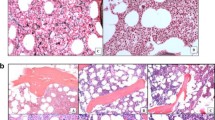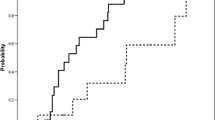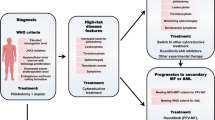Abstract
Background
At present, the treatment of polycythemia vera (PV) and essential thrombocythemia (ET) is still largely supportive and symptomatic. Homoharringtonine (HHT), a valid drug for treating chronic myelogenous leukemia, has shown some effect on leukemic stem cells. The aim of this study was to observe the effect of HHT on patients with high-risk PV and ET.
Methods
Patients with high-risk PV (n = 17) or ET (n = 18) who had failed or were intolerant to hydroxycarbamide or interferon-α therapy received HHT at a dose of 1.5 mg/m2 daily by continuous infusion for 7 days every month. Hematological responses were evaluated at the 6th month after HHT therapy.
Results
After six courses of HHT therapy, the hematological response rates were 64.7 % (11/17) in PV and 72.2 % (13/18) in ET. In PV, the single sign remission rates of constitutional symptoms, symptomatic splenomegaly, pruritus and bone pain were 70.0 % (7/10), 77.8 % (7/9), 50 % (1/2) and 100 % (3/3), respectively. The remission rates of constitutional symptoms and symptomatic splenomegaly in ET were 66.7 % (6/9) and 71.4 % (5/7), respectively. The rates of grade 1 granulocytopenia and thrombocytopenia were 1.8 and 0.9 %, respectively. No grade 2 or over events, or pancytopenia were observed.
Conclusions
Low-dose HHT alone has considerable short-term efficacy for high-risk PV/ET and may used as a second-line drug for PV/ET treatment in patients who have failed or were intolerant to hydroxycarbamide or interferon-α therapy.

Similar content being viewed by others
References
Guglielmelli P, Vannucchi AM (2010) Recent advances in diagnosis and treatment of chronic myeloproliferative neoplasms. Med Rep 24:1–6
Kiladjian JJ, Chomienne C, Fenaux P (2008) Interferon-alpha therapy in bcr-abl-negative myeloproliferative neoplasms. Leukemia 22:1990–1998
Levine RL, Heaney M (2008) New advances in the pathogenesis and therapy of essential thrombocythemia. Hematol Am Soc Hematol Educ Program 2008:76–82
Barosi G, Lupo L, Rosti V (2012) Management of myeloproliferative neoplasms: from academic guidelines to clinical practice. Curr Hematol Malig Rep 7:50–56
Li Y, Deng Z, Xuan H et al (2009) Prolonged chronic phase in chronic myelogenous leukemia after homoharringtonine therapy. Chin Med J (Engl) 122:1413–1417
Li Y, Liu X, Liu D et al (2009) The effect of homoharringtonine in patients with chronic myeloid leukemia who have failed or responded suboptimally to imatinib therapy. Leuk Lymphoma 50:1889–1891
Stone RM, Donohue KA, Stock W et al (2009) A phase II study of continuous infusion homoharringtonine and cytarabine in newly diagnosed patients with chronic myeloid leukemia: CALGB study 19804. Cancer Chemother Pharmacol 63:859–864
Quintás-Cardama A, Kantarjian H, Garcia-Maner G et al (2007) Phase I/II study of subcutaneous homoharringtonine in patients with chronic myeloid leukemia who have failed prior therapy. Cancer 109:248–255
Chen Y, Hu Y, Michaels S et al (2009) Inhibitory effects of omacetaxine on leukemic stem cells and BCR-ABL-induced chronic myeloid leukemia and acute lymphoblastic leukemia in mice. Leukemia 23:1446–1454
Wetzler M, Segal D (2011) Omacetaxine as an anticancer therapeutic: what is old is new again. Curr Pharm Des 17:59–64
Vardiman JW, Brunning RD, Harris NL (2001) WHO histological classification of chronic myeloproliferative diseases. In: Jaffe ES, Harris NL, Stein H, Vardiman JW (eds) World Health Organization classification of tumors: tumours of the haematopoietic and lymphoid tissues. Lyon: International Agency for Research on Cancer (IARC) Press, pp 17–44
Vardiman JW, Thiele J, Arber DA et al (2008) The 2008 revision of the World Health Organization (WHO) classification of myeloid neoplasms and acute leukemia: rationale and important changes. Blood 114:937–951
Harrison C (2010) Rethinking disease definitions and therapeutic strategies in essential thrombocythemia and polycythemia vera. Hematol Am Soc Hematol Educ Program 2010:129–134
Barbui T, Barosi G, Birgegard G et al (2011) Philadelphia-negative classical myeloproliferative neoplasms: critical concepts and management recommendations from European LeukemiaNet. J Clin Oncol 29:761–770
Hoffman R, Prchal JT, Samuelson S et al (2007) Philadelphia chromosome-negative myeloproliferative disorders: biology and treatment. Biol Blood Marrow Transplant 13(Suppl 1):64–72
Hasselbalch HC, Larsen TS, Riley CH et al (2011) Interferon-alpha in the treatment of Philadelphia-negative chronic myeloproliferative neoplasms. Status and perspectives. Curr Drug Targets 12:392–419
Antonioli E, Carobbio A, Pieri L et al (2010) Hydroxyurea does not appreciably reduce JAK2 V617F allele burden in patients with polycythemia vera or essential thrombocythemia. Haematologica 95:1435–1438
Conflict of interest
No author has any conflict of interest.
Author information
Authors and Affiliations
Corresponding author
About this article
Cite this article
Li, Y., Zhu, J. & Ding, B. Homoharringtonine is an effective therapy for patients with polycythemia vera or essential thrombocythemia who have failed or were intolerant to hydroxycarbamide or interferon-α therapy. Int J Clin Oncol 18, 922–926 (2013). https://doi.org/10.1007/s10147-012-0453-1
Received:
Accepted:
Published:
Issue Date:
DOI: https://doi.org/10.1007/s10147-012-0453-1




